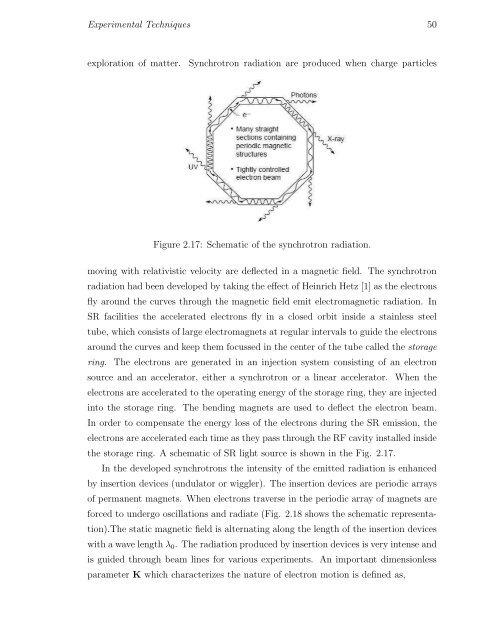PHYS07200604007 Manas Kumar Dala - Homi Bhabha National ...
PHYS07200604007 Manas Kumar Dala - Homi Bhabha National ...
PHYS07200604007 Manas Kumar Dala - Homi Bhabha National ...
Create successful ePaper yourself
Turn your PDF publications into a flip-book with our unique Google optimized e-Paper software.
Experimental Techniques 50<br />
exploration of matter. Synchrotron radiation are produced when charge particles<br />
Figure 2.17: Schematic of the synchrotron radiation.<br />
moving with relativistic velocity are deflected in a magnetic field. The synchrotron<br />
radiation had been developed by taking the effect of Heinrich Hetz [1] as the electrons<br />
fly around the curves through the magnetic field emit electromagnetic radiation. In<br />
SR facilities the accelerated electrons fly in a closed orbit inside a stainless steel<br />
tube, which consists of large electromagnets at regular intervals to guide the electrons<br />
around the curves and keep them focussed in the center of the tube called the storage<br />
ring. The electrons are generated in an injection system consisting of an electron<br />
source and an accelerator, either a synchrotron or a linear accelerator. When the<br />
electrons are accelerated to the operating energy of the storage ring, they are injected<br />
into the storage ring. The bending magnets are used to deflect the electron beam.<br />
In order to compensate the energy loss of the electrons during the SR emission, the<br />
electrons are accelerated each time as they pass through the RF cavity installed inside<br />
the storage ring. A schematic of SR light source is shown in the Fig. 2.17.<br />
In the developed synchrotrons the intensity of the emitted radiation is enhanced<br />
by insertion devices (undulator or wiggler). The insertion devices are periodic arrays<br />
of permanent magnets. When electrons traverse in the periodic array of magnets are<br />
forced to undergo oscillations and radiate (Fig. 2.18 shows the schematic representation).The<br />
static magnetic field is alternating along the length of the insertion devices<br />
with a wave length λ 0 . The radiation produced by insertion devices is very intense and<br />
is guided through beam lines for various experiments. An important dimensionless<br />
parameter K which characterizes the nature of electron motion is defined as,
















